Primary Health Care Strategy Evaluation: NUR3101 Assignment
VerifiedAdded on 2022/09/26
|7
|1449
|26
Report
AI Summary
This report analyzes Australia's National Primary Health Care (PHC) Strategic Framework, focusing on the strategy of promoting multidisciplinary teams. It examines the framework's key components, including determinants of health like equity and social justice, and epidemiological factors. The assignment evaluates these concepts in relation to the World Health Organization's (WHO) five key principles of PHC: accessibility, health promotion, appropriate technology, public participation, and intersectoral cooperation. The report emphasizes the significance of the strategy for nursing practice, highlighting the roles and responsibilities of nurses within multidisciplinary teams, especially in remote, rural, and regional areas, to ensure equitable access to health services. The analysis also reflects on how the strategy aligns with WHO principles and contributes to improved patient care, coordinated service delivery, and increased access to healthcare for all Australians.
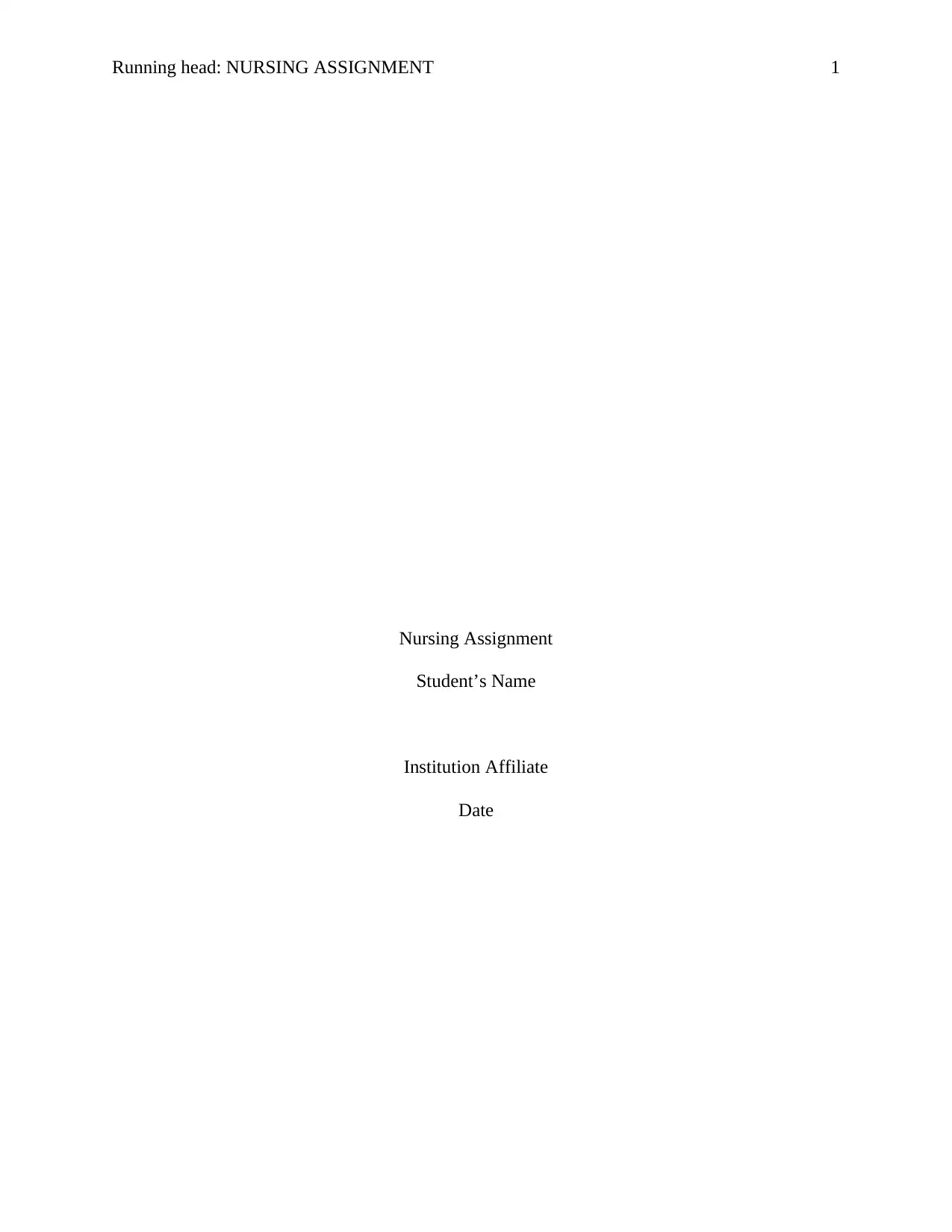
Running head: NURSING ASSIGNMENT 1
Nursing Assignment
Student’s Name
Institution Affiliate
Date
Nursing Assignment
Student’s Name
Institution Affiliate
Date
Paraphrase This Document
Need a fresh take? Get an instant paraphrase of this document with our AI Paraphraser
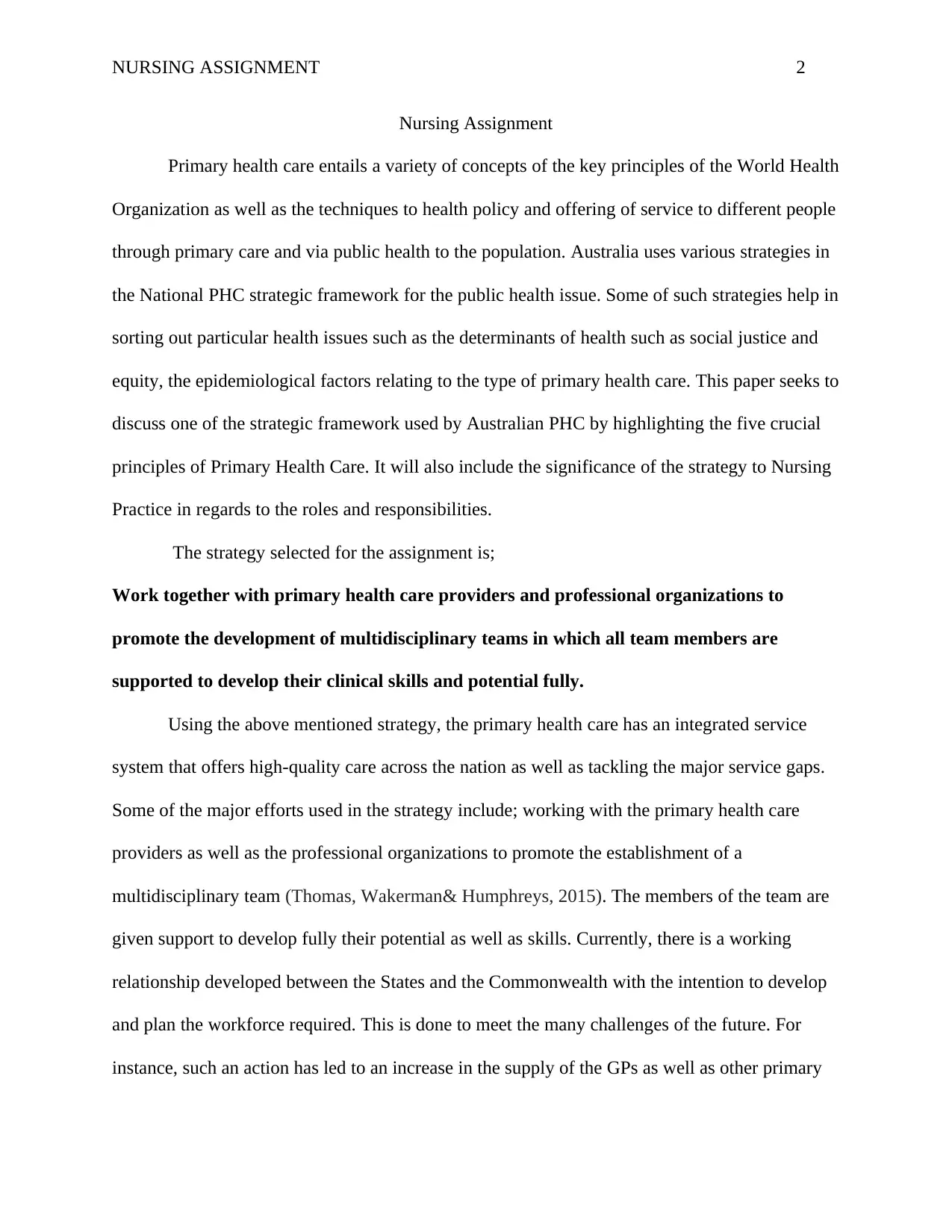
NURSING ASSIGNMENT 2
Nursing Assignment
Primary health care entails a variety of concepts of the key principles of the World Health
Organization as well as the techniques to health policy and offering of service to different people
through primary care and via public health to the population. Australia uses various strategies in
the National PHC strategic framework for the public health issue. Some of such strategies help in
sorting out particular health issues such as the determinants of health such as social justice and
equity, the epidemiological factors relating to the type of primary health care. This paper seeks to
discuss one of the strategic framework used by Australian PHC by highlighting the five crucial
principles of Primary Health Care. It will also include the significance of the strategy to Nursing
Practice in regards to the roles and responsibilities.
The strategy selected for the assignment is;
Work together with primary health care providers and professional organizations to
promote the development of multidisciplinary teams in which all team members are
supported to develop their clinical skills and potential fully.
Using the above mentioned strategy, the primary health care has an integrated service
system that offers high-quality care across the nation as well as tackling the major service gaps.
Some of the major efforts used in the strategy include; working with the primary health care
providers as well as the professional organizations to promote the establishment of a
multidisciplinary team (Thomas, Wakerman& Humphreys, 2015). The members of the team are
given support to develop fully their potential as well as skills. Currently, there is a working
relationship developed between the States and the Commonwealth with the intention to develop
and plan the workforce required. This is done to meet the many challenges of the future. For
instance, such an action has led to an increase in the supply of the GPs as well as other primary
Nursing Assignment
Primary health care entails a variety of concepts of the key principles of the World Health
Organization as well as the techniques to health policy and offering of service to different people
through primary care and via public health to the population. Australia uses various strategies in
the National PHC strategic framework for the public health issue. Some of such strategies help in
sorting out particular health issues such as the determinants of health such as social justice and
equity, the epidemiological factors relating to the type of primary health care. This paper seeks to
discuss one of the strategic framework used by Australian PHC by highlighting the five crucial
principles of Primary Health Care. It will also include the significance of the strategy to Nursing
Practice in regards to the roles and responsibilities.
The strategy selected for the assignment is;
Work together with primary health care providers and professional organizations to
promote the development of multidisciplinary teams in which all team members are
supported to develop their clinical skills and potential fully.
Using the above mentioned strategy, the primary health care has an integrated service
system that offers high-quality care across the nation as well as tackling the major service gaps.
Some of the major efforts used in the strategy include; working with the primary health care
providers as well as the professional organizations to promote the establishment of a
multidisciplinary team (Thomas, Wakerman& Humphreys, 2015). The members of the team are
given support to develop fully their potential as well as skills. Currently, there is a working
relationship developed between the States and the Commonwealth with the intention to develop
and plan the workforce required. This is done to meet the many challenges of the future. For
instance, such an action has led to an increase in the supply of the GPs as well as other primary
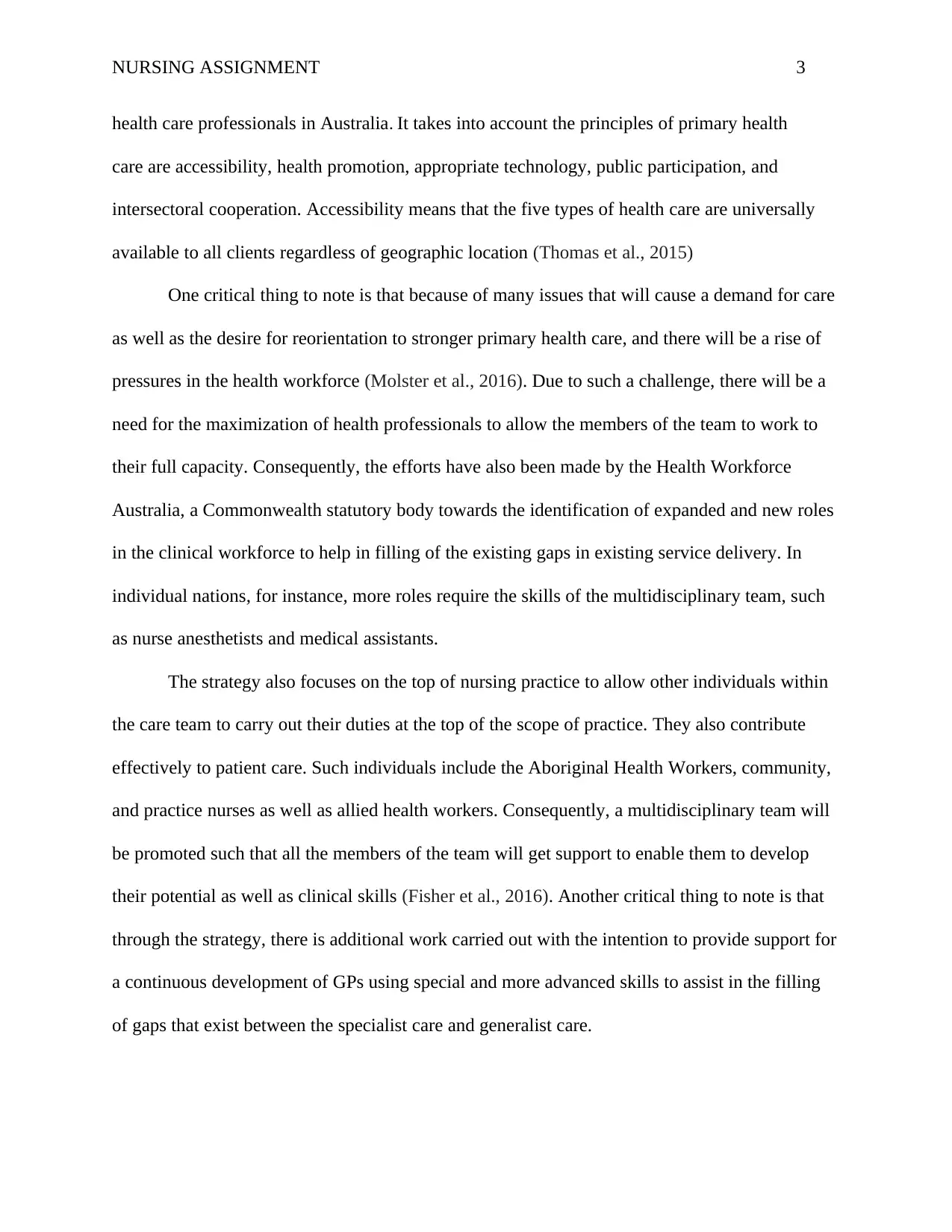
NURSING ASSIGNMENT 3
health care professionals in Australia. It takes into account the principles of primary health
care are accessibility, health promotion, appropriate technology, public participation, and
intersectoral cooperation. Accessibility means that the five types of health care are universally
available to all clients regardless of geographic location (Thomas et al., 2015)
One critical thing to note is that because of many issues that will cause a demand for care
as well as the desire for reorientation to stronger primary health care, and there will be a rise of
pressures in the health workforce (Molster et al., 2016). Due to such a challenge, there will be a
need for the maximization of health professionals to allow the members of the team to work to
their full capacity. Consequently, the efforts have also been made by the Health Workforce
Australia, a Commonwealth statutory body towards the identification of expanded and new roles
in the clinical workforce to help in filling of the existing gaps in existing service delivery. In
individual nations, for instance, more roles require the skills of the multidisciplinary team, such
as nurse anesthetists and medical assistants.
The strategy also focuses on the top of nursing practice to allow other individuals within
the care team to carry out their duties at the top of the scope of practice. They also contribute
effectively to patient care. Such individuals include the Aboriginal Health Workers, community,
and practice nurses as well as allied health workers. Consequently, a multidisciplinary team will
be promoted such that all the members of the team will get support to enable them to develop
their potential as well as clinical skills (Fisher et al., 2016). Another critical thing to note is that
through the strategy, there is additional work carried out with the intention to provide support for
a continuous development of GPs using special and more advanced skills to assist in the filling
of gaps that exist between the specialist care and generalist care.
health care professionals in Australia. It takes into account the principles of primary health
care are accessibility, health promotion, appropriate technology, public participation, and
intersectoral cooperation. Accessibility means that the five types of health care are universally
available to all clients regardless of geographic location (Thomas et al., 2015)
One critical thing to note is that because of many issues that will cause a demand for care
as well as the desire for reorientation to stronger primary health care, and there will be a rise of
pressures in the health workforce (Molster et al., 2016). Due to such a challenge, there will be a
need for the maximization of health professionals to allow the members of the team to work to
their full capacity. Consequently, the efforts have also been made by the Health Workforce
Australia, a Commonwealth statutory body towards the identification of expanded and new roles
in the clinical workforce to help in filling of the existing gaps in existing service delivery. In
individual nations, for instance, more roles require the skills of the multidisciplinary team, such
as nurse anesthetists and medical assistants.
The strategy also focuses on the top of nursing practice to allow other individuals within
the care team to carry out their duties at the top of the scope of practice. They also contribute
effectively to patient care. Such individuals include the Aboriginal Health Workers, community,
and practice nurses as well as allied health workers. Consequently, a multidisciplinary team will
be promoted such that all the members of the team will get support to enable them to develop
their potential as well as clinical skills (Fisher et al., 2016). Another critical thing to note is that
through the strategy, there is additional work carried out with the intention to provide support for
a continuous development of GPs using special and more advanced skills to assist in the filling
of gaps that exist between the specialist care and generalist care.
⊘ This is a preview!⊘
Do you want full access?
Subscribe today to unlock all pages.

Trusted by 1+ million students worldwide
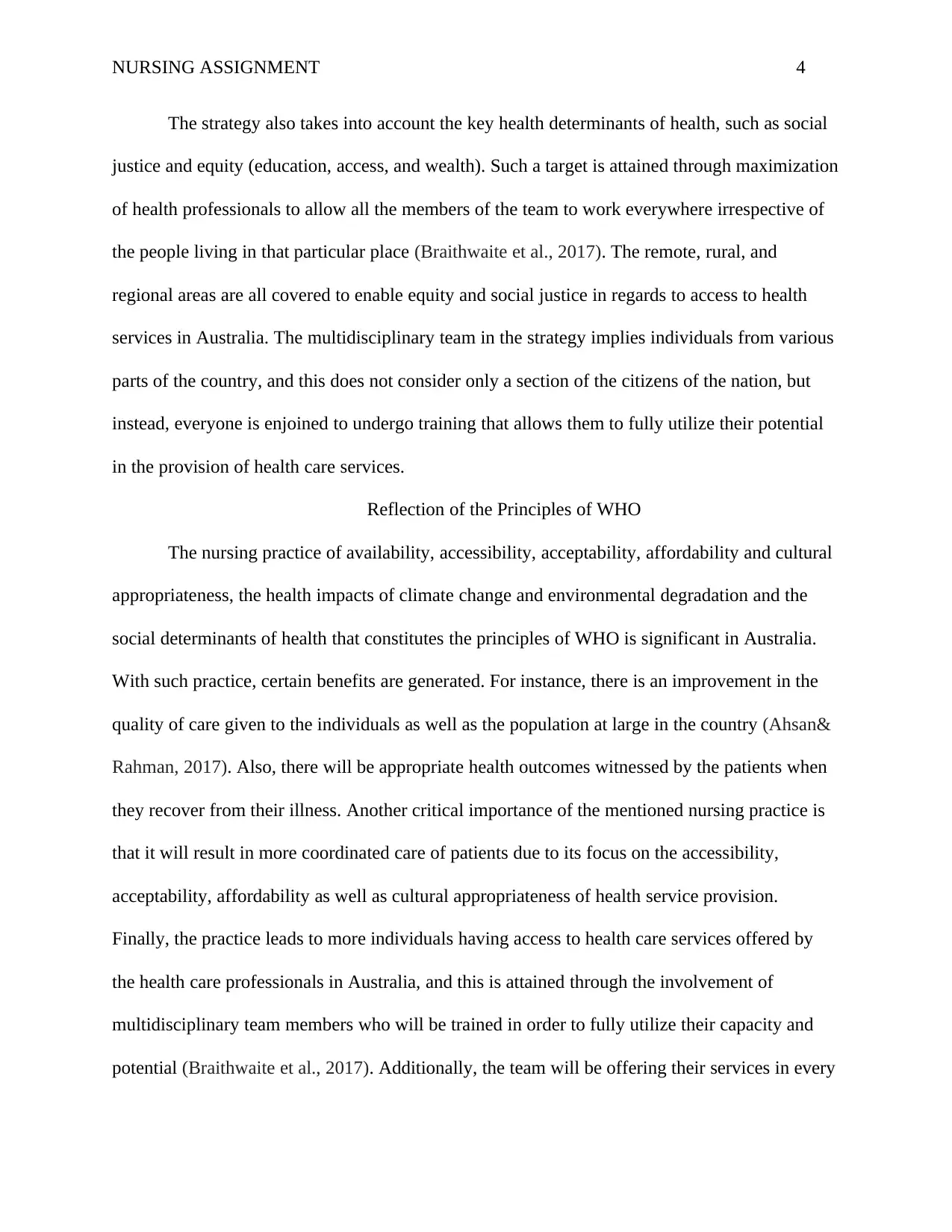
NURSING ASSIGNMENT 4
The strategy also takes into account the key health determinants of health, such as social
justice and equity (education, access, and wealth). Such a target is attained through maximization
of health professionals to allow all the members of the team to work everywhere irrespective of
the people living in that particular place (Braithwaite et al., 2017). The remote, rural, and
regional areas are all covered to enable equity and social justice in regards to access to health
services in Australia. The multidisciplinary team in the strategy implies individuals from various
parts of the country, and this does not consider only a section of the citizens of the nation, but
instead, everyone is enjoined to undergo training that allows them to fully utilize their potential
in the provision of health care services.
Reflection of the Principles of WHO
The nursing practice of availability, accessibility, acceptability, affordability and cultural
appropriateness, the health impacts of climate change and environmental degradation and the
social determinants of health that constitutes the principles of WHO is significant in Australia.
With such practice, certain benefits are generated. For instance, there is an improvement in the
quality of care given to the individuals as well as the population at large in the country (Ahsan&
Rahman, 2017). Also, there will be appropriate health outcomes witnessed by the patients when
they recover from their illness. Another critical importance of the mentioned nursing practice is
that it will result in more coordinated care of patients due to its focus on the accessibility,
acceptability, affordability as well as cultural appropriateness of health service provision.
Finally, the practice leads to more individuals having access to health care services offered by
the health care professionals in Australia, and this is attained through the involvement of
multidisciplinary team members who will be trained in order to fully utilize their capacity and
potential (Braithwaite et al., 2017). Additionally, the team will be offering their services in every
The strategy also takes into account the key health determinants of health, such as social
justice and equity (education, access, and wealth). Such a target is attained through maximization
of health professionals to allow all the members of the team to work everywhere irrespective of
the people living in that particular place (Braithwaite et al., 2017). The remote, rural, and
regional areas are all covered to enable equity and social justice in regards to access to health
services in Australia. The multidisciplinary team in the strategy implies individuals from various
parts of the country, and this does not consider only a section of the citizens of the nation, but
instead, everyone is enjoined to undergo training that allows them to fully utilize their potential
in the provision of health care services.
Reflection of the Principles of WHO
The nursing practice of availability, accessibility, acceptability, affordability and cultural
appropriateness, the health impacts of climate change and environmental degradation and the
social determinants of health that constitutes the principles of WHO is significant in Australia.
With such practice, certain benefits are generated. For instance, there is an improvement in the
quality of care given to the individuals as well as the population at large in the country (Ahsan&
Rahman, 2017). Also, there will be appropriate health outcomes witnessed by the patients when
they recover from their illness. Another critical importance of the mentioned nursing practice is
that it will result in more coordinated care of patients due to its focus on the accessibility,
acceptability, affordability as well as cultural appropriateness of health service provision.
Finally, the practice leads to more individuals having access to health care services offered by
the health care professionals in Australia, and this is attained through the involvement of
multidisciplinary team members who will be trained in order to fully utilize their capacity and
potential (Braithwaite et al., 2017). Additionally, the team will be offering their services in every
Paraphrase This Document
Need a fresh take? Get an instant paraphrase of this document with our AI Paraphraser
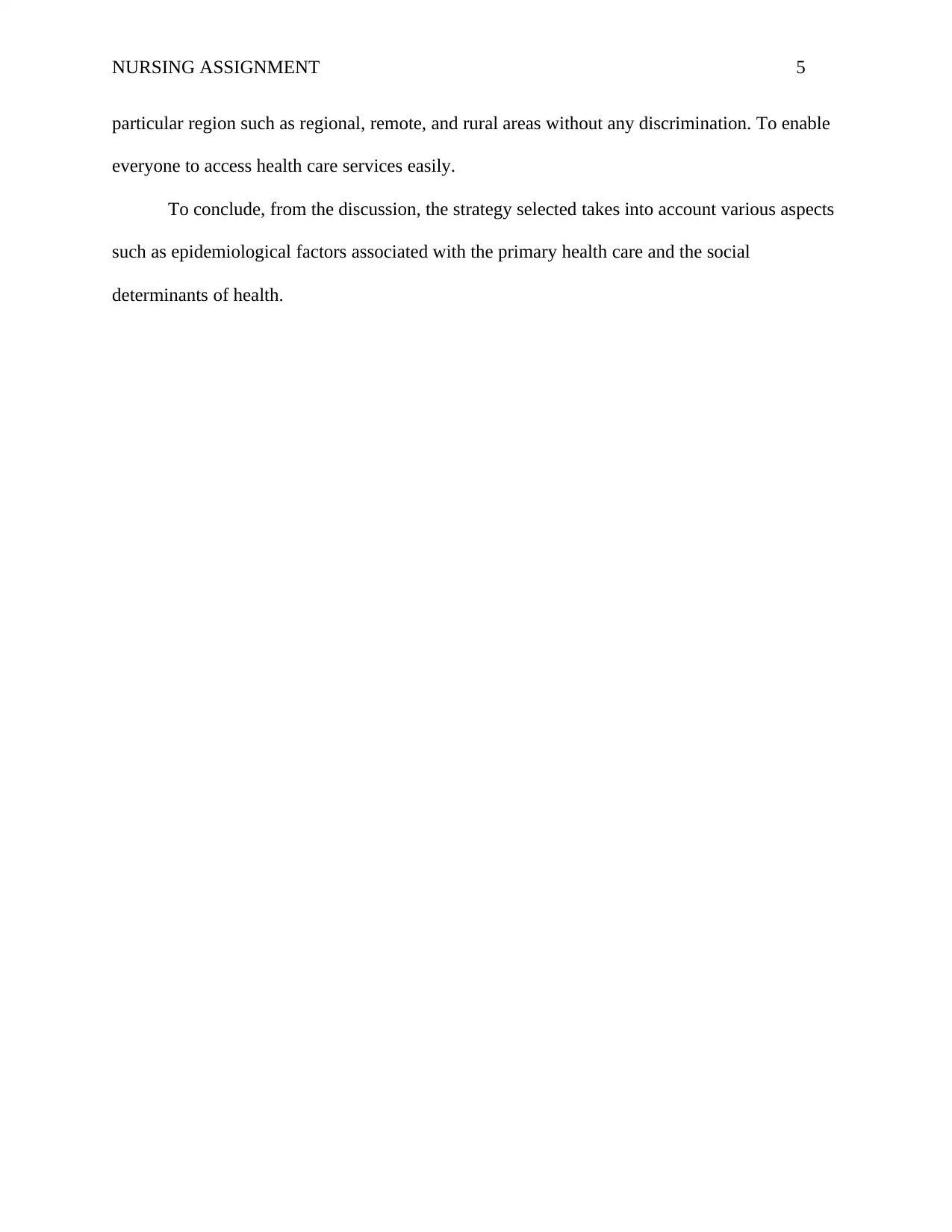
NURSING ASSIGNMENT 5
particular region such as regional, remote, and rural areas without any discrimination. To enable
everyone to access health care services easily.
To conclude, from the discussion, the strategy selected takes into account various aspects
such as epidemiological factors associated with the primary health care and the social
determinants of health.
particular region such as regional, remote, and rural areas without any discrimination. To enable
everyone to access health care services easily.
To conclude, from the discussion, the strategy selected takes into account various aspects
such as epidemiological factors associated with the primary health care and the social
determinants of health.
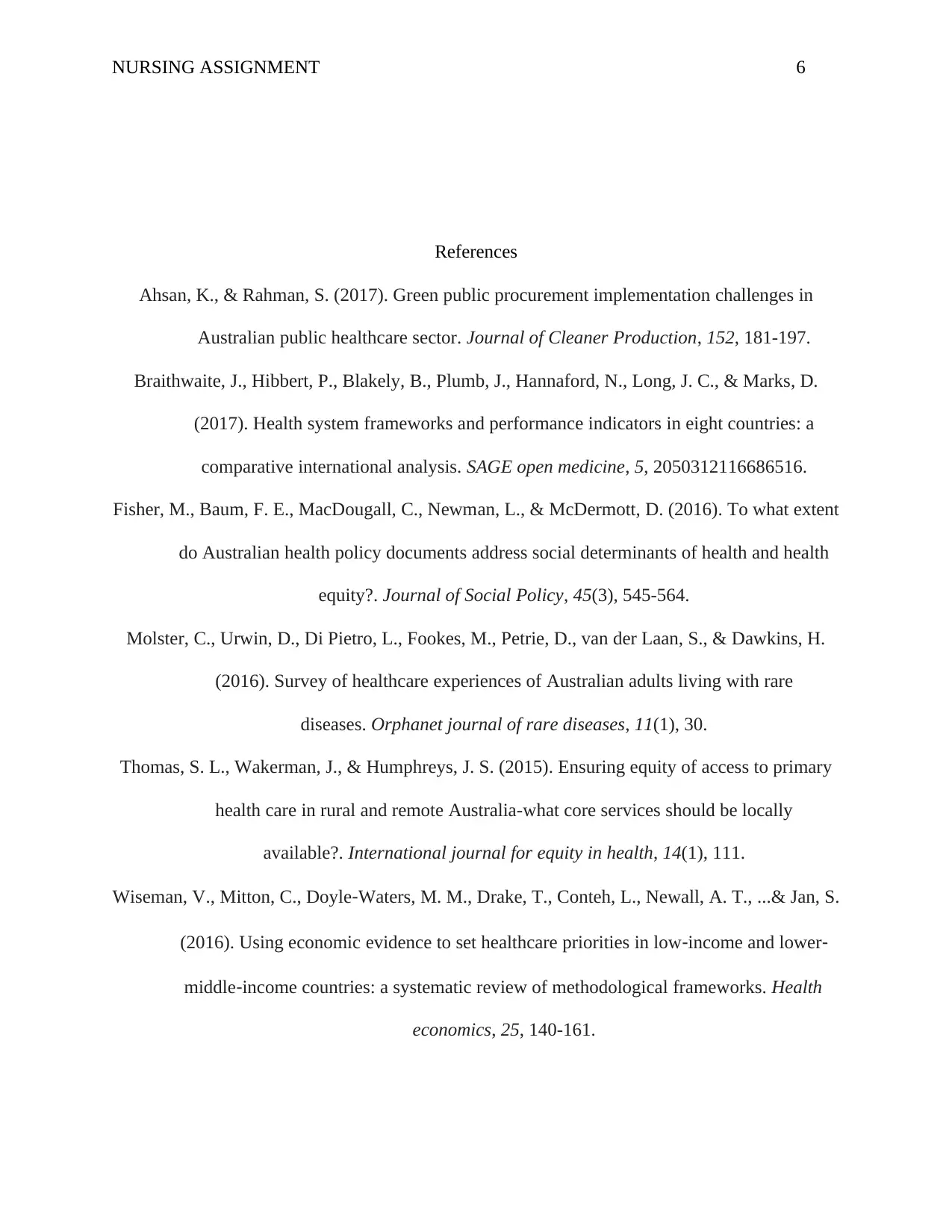
NURSING ASSIGNMENT 6
References
Ahsan, K., & Rahman, S. (2017). Green public procurement implementation challenges in
Australian public healthcare sector. Journal of Cleaner Production, 152, 181-197.
Braithwaite, J., Hibbert, P., Blakely, B., Plumb, J., Hannaford, N., Long, J. C., & Marks, D.
(2017). Health system frameworks and performance indicators in eight countries: a
comparative international analysis. SAGE open medicine, 5, 2050312116686516.
Fisher, M., Baum, F. E., MacDougall, C., Newman, L., & McDermott, D. (2016). To what extent
do Australian health policy documents address social determinants of health and health
equity?. Journal of Social Policy, 45(3), 545-564.
Molster, C., Urwin, D., Di Pietro, L., Fookes, M., Petrie, D., van der Laan, S., & Dawkins, H.
(2016). Survey of healthcare experiences of Australian adults living with rare
diseases. Orphanet journal of rare diseases, 11(1), 30.
Thomas, S. L., Wakerman, J., & Humphreys, J. S. (2015). Ensuring equity of access to primary
health care in rural and remote Australia-what core services should be locally
available?. International journal for equity in health, 14(1), 111.
Wiseman, V., Mitton, C., Doyle‐Waters, M. M., Drake, T., Conteh, L., Newall, A. T., ...& Jan, S.
(2016). Using economic evidence to set healthcare priorities in low‐income and lower‐
middle‐income countries: a systematic review of methodological frameworks. Health
economics, 25, 140-161.
References
Ahsan, K., & Rahman, S. (2017). Green public procurement implementation challenges in
Australian public healthcare sector. Journal of Cleaner Production, 152, 181-197.
Braithwaite, J., Hibbert, P., Blakely, B., Plumb, J., Hannaford, N., Long, J. C., & Marks, D.
(2017). Health system frameworks and performance indicators in eight countries: a
comparative international analysis. SAGE open medicine, 5, 2050312116686516.
Fisher, M., Baum, F. E., MacDougall, C., Newman, L., & McDermott, D. (2016). To what extent
do Australian health policy documents address social determinants of health and health
equity?. Journal of Social Policy, 45(3), 545-564.
Molster, C., Urwin, D., Di Pietro, L., Fookes, M., Petrie, D., van der Laan, S., & Dawkins, H.
(2016). Survey of healthcare experiences of Australian adults living with rare
diseases. Orphanet journal of rare diseases, 11(1), 30.
Thomas, S. L., Wakerman, J., & Humphreys, J. S. (2015). Ensuring equity of access to primary
health care in rural and remote Australia-what core services should be locally
available?. International journal for equity in health, 14(1), 111.
Wiseman, V., Mitton, C., Doyle‐Waters, M. M., Drake, T., Conteh, L., Newall, A. T., ...& Jan, S.
(2016). Using economic evidence to set healthcare priorities in low‐income and lower‐
middle‐income countries: a systematic review of methodological frameworks. Health
economics, 25, 140-161.
⊘ This is a preview!⊘
Do you want full access?
Subscribe today to unlock all pages.

Trusted by 1+ million students worldwide

NURSING ASSIGNMENT 7
1 out of 7
Related Documents
Your All-in-One AI-Powered Toolkit for Academic Success.
+13062052269
info@desklib.com
Available 24*7 on WhatsApp / Email
![[object Object]](/_next/static/media/star-bottom.7253800d.svg)
Unlock your academic potential
Copyright © 2020–2025 A2Z Services. All Rights Reserved. Developed and managed by ZUCOL.





